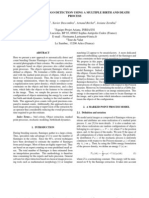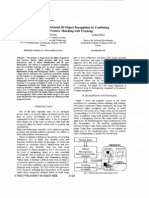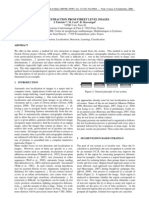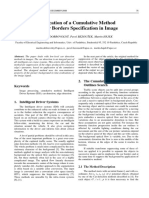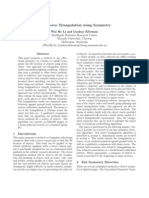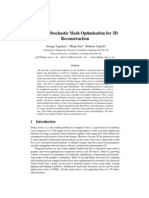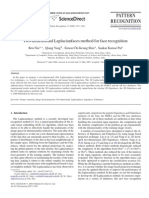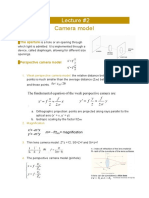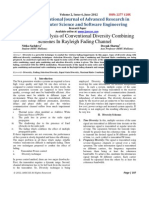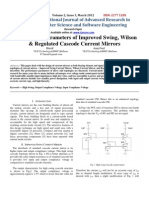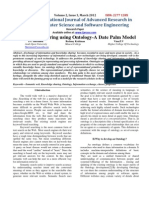Object Tracking Based On Pattern Matching
Object Tracking Based On Pattern Matching
Uploaded by
editor_ijarcsse0 ratings0% found this document useful (0 votes)
20 views4 pagesA novel algorithm for object tracking in video pictures, based on edge detection, object extraction and pattern matching is propsed. With the edge detection, we can detect all objects in images no matter whether they are moving or not. Using edge detection results of successive frames, we exploit pattern matching in a simple feature space for tracking of the objects.
Original Description:
Original Title
V2I2006
Copyright
© Attribution Non-Commercial (BY-NC)
Available Formats
PDF, TXT or read online from Scribd
Share this document
Did you find this document useful?
Is this content inappropriate?
Report this DocumentA novel algorithm for object tracking in video pictures, based on edge detection, object extraction and pattern matching is propsed. With the edge detection, we can detect all objects in images no matter whether they are moving or not. Using edge detection results of successive frames, we exploit pattern matching in a simple feature space for tracking of the objects.
Copyright:
Attribution Non-Commercial (BY-NC)
Available Formats
Download as PDF, TXT or read online from Scribd
Download as pdf or txt
0 ratings0% found this document useful (0 votes)
20 views4 pagesObject Tracking Based On Pattern Matching
Object Tracking Based On Pattern Matching
Uploaded by
editor_ijarcsseA novel algorithm for object tracking in video pictures, based on edge detection, object extraction and pattern matching is propsed. With the edge detection, we can detect all objects in images no matter whether they are moving or not. Using edge detection results of successive frames, we exploit pattern matching in a simple feature space for tracking of the objects.
Copyright:
Attribution Non-Commercial (BY-NC)
Available Formats
Download as PDF, TXT or read online from Scribd
Download as pdf or txt
You are on page 1of 4
Volume 2, Issue 2, February 2012 ISSN: 2277 128X
International Journal of Advanced Research in
Computer Science and Software Engineering
Research Paper
Available online at: www.ijarcsse.com
Object Tracking Based on Pattern Matching
V.Purandhar Reddy
Associate Professor, Dept of ECE,
S V College of Engineering,
Tirupati-517501
Abstract In this paper a novel algorithm for object tracking in video pictures, based on edge detection, object extraction and pattern
matching is propsed. With the edge detection, we can detect all objects in images no matter whether they are moving or not. Using
edge detection results of successive frames, we exploit pattern matching in a simple feature space for tracking of the objects.
Consequently, the proposed algorithm can be applied to multiple moving and still objects even in the case of a moving camera. We
describe the algorithm in detail and perform simulation experiments on object tracking which verify the tracking algorithms
efficiency.
I. INTRODUCTION
The moving object tracking in video pictures has attracted
a great deal of interest in computer vision. For object
recognition, navigation systems and surveillance systems,
object tracking is an indispensable first-step.
The conventional approach to object
tracking is based on the difference between the current
image and the background image. However, algorithms
based on the difference image cannot simultaneously
detect still objects. Furthermore, they cannot be applied to
the case of a moving camera. Algorithms including the
camera motion information have been proposed previously,
but, they still contain problems in separating the
information from the background.
In this paper, we propose edge
Detection based Mathod for object tracking in video
pictures. Our algorithm is based on Edge detection, object
extraction and pattern matching. With the edge detection,
we can extract all objects in images. The proposed method
for tracking uses pattern matching between successive
frames. As a consequence, the algorithm can
simultaneously track multiple moving and still objects in
video pictures.
This paper is organized as follows. The
proposed method consisting of stages edge detection,
objects extraction, features extraction & object tracking is
described in detail.
II. PROPOSED CONCEPT FOR MOVING OBJECTS
TRACKING
A. Edge Detection
A problem of fundamental importance in
image analysis is edge detection. Edges characterize object
boundaries and are therefore useful for segmentation,
registration, and identification of objects in scenes. Edge
points can be thought of as pixel locations of abrupt gray-
level change.
In developed algorithm gradient operator method is
used. For digital images these operators also called masks,
represent finite difference approximations of either the
orthogonal gradients f
x,
f
y
or the directional gradient f/r.
let H denote a p p mask and define, for
an arbitrary image U, their inner product at location (m,n)
as the correlation <U,H>
m,n
~
i
I
h(i, j) u(i+m, j+n) =
u(m,n) h ( -m,-n ) here the symbol represents the
convolution.
Let us consider the pair of sobel masks
And
boxed element indicates the location of an object .The
masks H
1
,H
2
measures the gradient of the image U(m,n) in
two orthogonal direction .
Defining the bidirectional gradients
g
1
(m, n) ~ <U,H
1
>
m,n
g
2
(m, n) ~ <U,H
2
>
m,n
the gradient vector magnitude and direction is given by
g (m, n) = ( g
1
(m,n)
2
+ g
2
(m,n)
2
)
1/2
u
g
(m, n)= tan
-1
(g
2
(m,n)
/ g
1
(m,n))
Often the magnitude gradient is calculated as
g (m, n) ~ g
1
(m,n)+g
2
(m,n)
Volume 2, issue 2, February 2012 www.ijarcsse.com
2012, IJARCSSE All Rights Reserved
. This calculation is easier to perform and is preferred
especially when implemented in digital hardware.
The sobel operator computes horizontal and
vertical differences of local sums. This reduces effect of
noise in the data. Noting that this operator have a desirable
property of yielding zeros for uniform regions.
The pixel location (m, n) is declared an edge
location if g(m, n) exceeds some threshold t. The
locations of edge points constitute an edge map (m,n),
which is defined as
Where
I
g
~ { (m,n) ; g (m, n) > t }
The edge map gives necessary data for
tracing the object boundaries in an image. Typically,t
may be selected using the cumulative histogram of g(m, n)
so that 5 to 10% of pixels with largest gradients are
declared as edges.
B. Boundary Extraction By Connectivity Method
Boundaries are linked edges that
characterize the shape of an object. They are useful in
computation in computation of geometry features such as
size or orientation. For extracting the boundaries of an
object connectivity method is used.
Conceptually, boundaries can be found by
tracing the connecting edges. On a rectangular grid a pixel
is said to be four- or eight-connected when it has the same
properties as one of its nearest four or eight neighbors,
respectively as shown in Fig.2(a ,b). There are difficulties
associated with these definitions of connectivity, as shown
in fig.2(c). Under four-connectivity, segments 1, 2, 3, and
4 would be classified as disjoint, although they are
perceived to form a connecting ring. Under eight-
connectivity these segments are connected, but the inside
hole (for example pixel B) is also eight-connected to the
outside (for instance, pixel C). Such problems can be
avoided by considering eight-connectivity for object and
four-connectivity for background. An alternative is to use
triangular or hexagonal grids, where three- or-six-
connectedness can be defined. However, there are other
practical difficulties that arise in working with non
rectangular grids.
Fig .2: connectivity on a rectangular grid .Pixel A and its
(a) 4- connected and (b) 8- connected neighbours;
c) connected paradox; are B and c connected ?
C. Feature Extraction For Objects
In this subsection, we describe the
extracted features of Extracted objects. Figure.3 shows an
example of a object for explanation purposes.
1)Area: By counting the number of pixels included in
object i of the t-th frame, we calculate the area of the
object a
i
(t).
Fig.3: Explanation of the proposed feature extraction from the object
extraction result.
2)Width And Height: We extract the positions of the pixel
P
xmax
(P
xmin
) which has the maximum (minimum) x-
component:
P
xmax
= (X
max,x
,X
max,y
),
P
xmin
= (X
min,x
,X
min,y
),
where X
max,x
, X
max,y
, X
min,x
, and X
min,y
are
the x- and y coordinates of the rightmost and leftmost
boundary of object i, respectively. In addition, we also
extract
P
ymax
= (Y
max,x
, Y
max,y
),
P
ymin
= (Y
min,x
, Y
min,y
).
1 0
1
(m, n)c I
g
thr
(m,n) =
Volume 2, issue 2, February 2012 www.ijarcsse.com
2012, IJARCSSE All Rights Reserved
Then we calculate the width w and the height h of the
objects as follows
w
i
(t) = X
max,x
X
min,x
,
h
i
(t) = Y
max,y
Y
min,y.
3) Position: We define the positions of each object in the
frame as follows
x
i
(t) = (X
max,x
+ X
min,x
)/2
y
i
(t) = (Y
max,y
+ Y
min,y
)/2
4)Color: Using the image data at P
xmax
, P
xmin
, P
ymax
and
P
ymin
, we define the color feature of each object for the R
(Red) component from original color frame
R
i
(t) = [R(P
xmax
) + R(P
xmin
) +R(P
ymax
) + R(P
ymin
)] /4,
as well as by equivalent equations for the G and B
components.
D. Objects Tracking And Distance Measure
The proposed algorithm for object tracking exploits pattern
matching with the features above and makes use of the
minimum distance search in the feature space. We now go
into more details of our algorithm.
Using the edge detection result of the
object i in the t-th frame, we first extract the features of the
object (N+1, i). Here, the notation (N+1, i) stands for the
objects i in the t-th frame. Then we perform the minimum
distance search in the feature space between (N+1, i) and
(N, j) for all objects j in the preceding frame. Finally, the
object (N+1, i) is identified with the object in the
preceding frame which has the minimum distance from
(N+1,i). Repeating this matching procedure for all objects
in the current frame, we can identify all objects one by one
and can keep track of the objects between frames.
Further refinements of the proposed algorithm are in order.
(1) We have not specified the distance measure used for
matching yet. In the simulation experiments we could
confirm that besides the Euclidean distance D
E
the
simpler Manhattan distance D
M
is already sufficient
for object tracking purposes.
(2) In order to treat all object features with equal weights,
it is necessary to normalize the features. One possible
way is dividing them by their maximum values.
Dividing by 2
n
, where the integer n is determined for
each feature so that approximately equal weights
results, is another possibility. The second possibility
has the advantage that the division can be realized by
a shifting operation in a hardware realization. Figure 4
shows a block diagram of proposed method & Figure
5 shows a Detailed description of the proposed object
tracking algorithm.
Fig. 4: Block diagram of proposed object tracking method.
[Objects Tracking Algorithm]
1) Convert the color image to gray scale image
2) Perform the edge detection by sobel edge
detection.
3) Dilate the image by boundary connectivity.
4) Extract all objects by labeling method
5) Feature Extraction
a) Extract the Features(Area, width, height &
color features) of object to track in N
th
Frame(ie previous frame)
b) Extract the Features (Area, width, height &
color features) of object to track in N+1
th
Frame( ie previous frame
6) Pattern Matching in the Feature
Space
a) Calculation of distances
Search for the minimum
Distance among the distances.
b) Apply Feature match of N
th
Frame object
with minimum distance object of N+1
th
Frame object if not matched perform the
feature match next minimum distance object
and so on .
c) After matching remove the data of N
th
Frame and store the data of N+1
th
Frame.
d) Increase the value of N by N+1 Repeat the
steps 1 to 6
.
Fig. 6: Detailed description of the proposed object tracking algorithm.
III. SIMULATION
The proposed algorithm is tested using Matlab 7.1.
For experimental verification two different video
Volume 2, issue 2, February 2012 www.ijarcsse.com
2012, IJARCSSE All Rights Reserved
sequences were taken from moving camera. Then frames
were extracted from the video sequences. Since all the
processing is done on gray scale images, 24 bit color
image frame is initially converted into gray scale frame of
8 bit size. By giving frames one by one to the Matlab
program of the proposed algorithm, the tracked object
segmentation is extracted. The dimension of the processing
image is 320240.
Frame
number
Object
tracked
result
Result of
the tracked
object
FRAME 1
----------
------------
FRAME 2
Pattern
matched
FRAME 3
Pattern
Matched
FRAME 4
Pattern
matched
FRAME 5
Pattern
matched
Fig. 7: The tracked object results from successive frames.
TABLE-I: EXTRACTED FEATURES FOR SAMPLE 1
F.
No
A W H P R G B
1
5
3.2
2.2
4.3
6.1
4.6
5.1
0.03
2
4.75
2.9
2.2
4.3
6.1
4.4
4.8
0.03
3
4.2
2.7
2.1
4.2
6.1
4.3
4.7
0.03
4
3.95
2.7
2
4.1
5.9
4.7
5.1
0.03
5
3.5
2.6
2.1
4
5.9
4.2
4.4
0.03
6
3.21
2.5
2
4
5.9
4.2
4.5
0.03
7
2.8
2.3
2
4
5.9
4.3
4.7
0.03
8
2.6
2
2.1
4.1
5.9
4
4.3
0.03
IV. CONCLUSION
We have proposed an object tracking algorithm for
video pictures, based on Edge detection and pattern
matching of the Extracted objects between frames in a
simple feature space. Simulation results for frame
sequences with moving objects verify the suitability of the
algorithm for reliable moving object tracking. We also
have confirmed that the algorithm works very well for
more complicated video pictures including rotating objects
and occlusion of objects.
In order to extract color features of Extracted
objects, we used four boundary pixels color features from
the original image. Thus, correct color features of an object
that has gradation or texture is not extracted. Nevertheless,
the mean value turns out to sufficiently represent the
objects color features for the tracking purpose.
REFERENCES
[1] A new appearance model based on object sub-region for tracking
Shu-
Peng Wang;Hong-BingJi; Wavelet Analysis and Pattern
Recognition, 2007. ICWAPR '07.
[2] A moving object tracking method based on sequential detection
scheme Qiu Xuena; Liu Shirong; Liu Fei; Zhu
Weitao;DuFangfang;Control Conference (CCC), 2010 29th Chinese.
[3] A stream field based partially observable moving object tracking
algorithm Kuo-ShihTseng;Control, Automation, Robotics and
Vision, 2008. ICARCV 2008. 10th International Conference.
[4] W. G. Kropatsch and H. Bischof, Digital Image Analysis,
Springer,
2001.
[5] G.L. Foresti, A real-time system for video surveillance of
unattended
outdoor environments, IEEE Trans. Circuits and Systems for Vid.
Tech., Vol. 8, No. 6, pp. 697704, 1998.
[6] C. Stauffer and W.E.L. Grimson, Learning patterns of activity
using
real-time tracking, IEEE Trans. PAMIL, Vol. 22, No. 8, pp. 747
757,
2000.
[7] H. Kimura and T. Shibata, Simple-architecture motion-detection
analog V-chip based on quasi-two-dimensional processing, Ext.
Abs.
of the 2002 Int. Conf. on Solid State Devices and Materials
(SSDM2002), pp. 240 241, 2002.
[8] S. W. Seol et al., An automatic detection and tracking system of
moving objects using double differential based motion estimation,
Proc.
of Int. Tech. Conf. Circ./Syst., Comput. and Comms. (ITC-
CSCC2003),
pp. 260 263, 2003.
[9 ] An embodiment of stereo vision system for mobile robot for real-
time
measuring distance and object tracking Ik-Hwan Kim; Do-Eun Kim;
You-Sung Cha; Kwang-hee Lee; Tae-Yong Kuc;
Control, Automation and Systems, 2007. ICCAS '07. International
Conference
[10] Image Segmentation and Pattern Matching Based FPGA/ASIC
Implementation Architecture of Real-Time Object Tracking
K. Yamaoka, T. Morimoto, H. Adachi, T. Koide, and H. J.
Mattausch
Research Center for Nanodevices and Systems, Hiroshima
University.
.
You might also like
- Second Periodical Test in Grade 8 MathematicsDocument6 pagesSecond Periodical Test in Grade 8 MathematicsAnna Lizette Clapis DeGuzman90% (72)
- Scene From "Proof" by David AubrunDocument11 pagesScene From "Proof" by David Aubrungenewng100% (2)
- Topic 11: Kinetics: Document May Have Been Altered From The OriginalDocument3 pagesTopic 11: Kinetics: Document May Have Been Altered From The OriginalLoh Jun XianNo ratings yet
- ITS Master 15963 Paper PDFDocument6 pagesITS Master 15963 Paper PDFAbdelrahim Hussam MoubayedNo ratings yet
- Paper 11-Shape Prediction Linear Algorithm Using FuzzyDocument5 pagesPaper 11-Shape Prediction Linear Algorithm Using FuzzyEditor IJACSANo ratings yet
- 3D Range Map Using Structured Light and Three-Point Epipolar ConstraintsDocument4 pages3D Range Map Using Structured Light and Three-Point Epipolar ConstraintsLeonardo Riccioppo GarcezNo ratings yet
- Region Covariance Based Object Tracking Using Monte Carlo MethodDocument4 pagesRegion Covariance Based Object Tracking Using Monte Carlo MethodVasuhi SamyduraiNo ratings yet
- Real-Time Image Processing Algorithms For Object and Distances Identification in Mobile Robot Trajectory PlanningDocument6 pagesReal-Time Image Processing Algorithms For Object and Distances Identification in Mobile Robot Trajectory PlanningamitsbhatiNo ratings yet
- Locating An Object of Interest in An Image Using Its Color FeatureDocument4 pagesLocating An Object of Interest in An Image Using Its Color Featureeditor_ijarcsseNo ratings yet
- Fiber Segmentation in Composite Materials Using Marked Point ProcessesDocument7 pagesFiber Segmentation in Composite Materials Using Marked Point ProcessesBarna KeresztesNo ratings yet
- Object TrackDocument5 pagesObject TrackEngr EbiNo ratings yet
- Improved Approach For Mobile Robotics in Pattern Recognition 3DDocument8 pagesImproved Approach For Mobile Robotics in Pattern Recognition 3DSelva GanapathyNo ratings yet
- Iran I 93 MotionDocument24 pagesIran I 93 MotionAlejandro PerezNo ratings yet
- 3D Reconstruction Based On Stereovision and Texture MappingDocument6 pages3D Reconstruction Based On Stereovision and Texture MappingBharat Chandra SahuNo ratings yet
- Subpixel Edge Detection Based On Morphological Theory: Yu Lei and Nie JiafaDocument4 pagesSubpixel Edge Detection Based On Morphological Theory: Yu Lei and Nie JiafarphmiNo ratings yet
- 2008 FlamingoDetection DescampsDocument4 pages2008 FlamingoDetection DescampskejadianNo ratings yet
- Paper Title: Author Name AffiliationDocument6 pagesPaper Title: Author Name AffiliationPritam PatilNo ratings yet
- Object Tracking Using High Resolution Satellite ImageryDocument15 pagesObject Tracking Using High Resolution Satellite ImageryashalizajohnNo ratings yet
- A Proposed Model For Segmentation of Spot Images: KEY WORDS: Photogrammetry, Automation, Extraction, Fuzzy, ImageDocument3 pagesA Proposed Model For Segmentation of Spot Images: KEY WORDS: Photogrammetry, Automation, Extraction, Fuzzy, ImageKobalt von KriegerischbergNo ratings yet
- Detection of Moving Object Based On Background SubtractionDocument4 pagesDetection of Moving Object Based On Background SubtractionInternational Journal of Application or Innovation in Engineering & ManagementNo ratings yet
- Robust Model-Based 3D Object Recognition by Combining Feature Matching With TrackingDocument6 pagesRobust Model-Based 3D Object Recognition by Combining Feature Matching With TrackingVinoth GunaSekaranNo ratings yet
- Asift AsiftDocument11 pagesAsift AsiftHaris MasoodNo ratings yet
- Digital Image Processing Unit-7Document3 pagesDigital Image Processing Unit-7Vam SiNo ratings yet
- Image Encryption Using Chaos Maps: Aarya Arun, Indu Rallabhandi, Rachana Jayaram November 2019Document17 pagesImage Encryption Using Chaos Maps: Aarya Arun, Indu Rallabhandi, Rachana Jayaram November 2019Animesh PrasadNo ratings yet
- Using Mean-Shift Tracking Algorithms For Real-Time Tracking of Moving Images On An Autonomous Vehicle Testbed PlatformDocument10 pagesUsing Mean-Shift Tracking Algorithms For Real-Time Tracking of Moving Images On An Autonomous Vehicle Testbed PlatformRe HoNo ratings yet
- Prs Lab Eng DTDocument7 pagesPrs Lab Eng DTTeodora FurcoviciNo ratings yet
- 1609 00096 PDFDocument6 pages1609 00096 PDFBudi RahmaniNo ratings yet
- Edge Detection-Application of (First and Second) Order Derivative in Image ProcessingDocument11 pagesEdge Detection-Application of (First and Second) Order Derivative in Image ProcessingBhuviNo ratings yet
- Image Algebra Techniques For Binary Image Component Labeling With Local OperatorsDocument23 pagesImage Algebra Techniques For Binary Image Component Labeling With Local Operatorsmanumini_0411No ratings yet
- Morphology Segmentation Edge LinkingDocument75 pagesMorphology Segmentation Edge Linkingjdjdsjdj KdjdjdNo ratings yet
- Computer Vision Using Fuzzy Logic For ManipulatorDocument9 pagesComputer Vision Using Fuzzy Logic For Manipulatortou kaiNo ratings yet
- Texture Based Segmentation: Abstract. The Ability of Human Observers To Discriminate Between Textures Is ReDocument8 pagesTexture Based Segmentation: Abstract. The Ability of Human Observers To Discriminate Between Textures Is ReMohammed Abdul RahmanNo ratings yet
- Digital Image Processing IntroductionDocument33 pagesDigital Image Processing IntroductionAshish KumarNo ratings yet
- TSPpaper 243Document5 pagesTSPpaper 243Leonardo BritoNo ratings yet
- Research On Recognition of Safety Helmet Wearing oDocument9 pagesResearch On Recognition of Safety Helmet Wearing oBinderiya BoldbaatarNo ratings yet
- Moving Object Tracking in Video Using MATLABDocument5 pagesMoving Object Tracking in Video Using MATLABSumeet SauravNo ratings yet
- Matching Gradient Descriptors With Topological Constraints To Characterise The Crowd DynamicsDocument6 pagesMatching Gradient Descriptors With Topological Constraints To Characterise The Crowd DynamicsKhairulNo ratings yet
- CMRT09 Fabrizio Et AlDocument6 pagesCMRT09 Fabrizio Et AlMahesh JangidNo ratings yet
- DIP - Lab 16105126016 Mamta KumariDocument28 pagesDIP - Lab 16105126016 Mamta Kumarimamta kumariNo ratings yet
- Robot Vision, Image Processing and Analysis: Sumit Mane (162110017) Akhilesh Gupta (162110001) Kunal Karnik (162110013)Document69 pagesRobot Vision, Image Processing and Analysis: Sumit Mane (162110017) Akhilesh Gupta (162110001) Kunal Karnik (162110013)Sanjay DolareNo ratings yet
- Local Greyvalue Invariants For Image Retrieval: Vector of Local CharacteristicsDocument6 pagesLocal Greyvalue Invariants For Image Retrieval: Vector of Local CharacteristicsjimakosjpNo ratings yet
- PXC 387549Document8 pagesPXC 387549Adisti Nuraprilia prasastiNo ratings yet
- Image Search by Features of Sorted Gray Level Histogram Polynomial CurveDocument6 pagesImage Search by Features of Sorted Gray Level Histogram Polynomial Curvematkhau01No ratings yet
- Application of A Cumulative Method For CDocument5 pagesApplication of A Cumulative Method For CwellflowcreativefirmNo ratings yet
- Como Observa Un RobotDocument38 pagesComo Observa Un RobotnerinconqNo ratings yet
- Webcam Motion Detection 2007Document4 pagesWebcam Motion Detection 2007anon-773497No ratings yet
- A New Binary Encoding Algorithm For The Integration of Hyperspectral Data and DSMDocument10 pagesA New Binary Encoding Algorithm For The Integration of Hyperspectral Data and DSMnramaraoNo ratings yet
- Domain Specific Cbir For Highly Textured ImagesDocument7 pagesDomain Specific Cbir For Highly Textured ImagescseijNo ratings yet
- Survey 2 PDFDocument43 pagesSurvey 2 PDFSeptian SNo ratings yet
- Linear Imaging Systems Example: The Pinhole Camera: OutlineDocument36 pagesLinear Imaging Systems Example: The Pinhole Camera: OutlinesriNo ratings yet
- Fast Stereo Triangulation Using SymmetryDocument7 pagesFast Stereo Triangulation Using Symmetrywai_li_8No ratings yet
- SegmentationDocument37 pagesSegmentationRe TyaraNo ratings yet
- Bayesian Stochastic Mesh Optimisation For 3D Reconstruction: George Vogiatzis Philip Torr Roberto CipollaDocument12 pagesBayesian Stochastic Mesh Optimisation For 3D Reconstruction: George Vogiatzis Philip Torr Roberto CipollaneilwuNo ratings yet
- 3dof Arm Design MechanicsDocument6 pages3dof Arm Design Mechanicshashim khanNo ratings yet
- Two-Dimensional Laplacianfaces Method For Face RecognitionDocument7 pagesTwo-Dimensional Laplacianfaces Method For Face RecognitionKeerti Kumar KorlapatiNo ratings yet
- Lecture #2: C Camera ModelDocument38 pagesLecture #2: C Camera ModelElisa PopNo ratings yet
- Comparative Study of ROI Extraction of Palmprint: 2. Square-Based MethodDocument5 pagesComparative Study of ROI Extraction of Palmprint: 2. Square-Based MethodHOD ITNo ratings yet
- Automatic Gradient Threshold Determination For Edge DetectionDocument4 pagesAutomatic Gradient Threshold Determination For Edge Detectionapi-3706534No ratings yet
- Performance Evaluation of Edge Detection Techniques For Images in Spatial DomainDocument8 pagesPerformance Evaluation of Edge Detection Techniques For Images in Spatial DomainJiwa AbdullahNo ratings yet
- Rashmi Springer PaperDocument6 pagesRashmi Springer PaperSandeep Kumar TiwariNo ratings yet
- Procedural Surface: Exploring Texture Generation and Analysis in Computer VisionFrom EverandProcedural Surface: Exploring Texture Generation and Analysis in Computer VisionNo ratings yet
- Computer Stereo Vision: Exploring Depth Perception in Computer VisionFrom EverandComputer Stereo Vision: Exploring Depth Perception in Computer VisionNo ratings yet
- Target Classification: An Application of Artificial Neural Network in Intelligent Transport SystemDocument4 pagesTarget Classification: An Application of Artificial Neural Network in Intelligent Transport Systemeditor_ijarcsseNo ratings yet
- Simulink Model Based Image SegmentationDocument4 pagesSimulink Model Based Image Segmentationeditor_ijarcsseNo ratings yet
- A Review of Various Grid Middleware TechnologiesDocument6 pagesA Review of Various Grid Middleware Technologieseditor_ijarcsseNo ratings yet
- Impact and Utilization of Wireless Sensor Network in Rural Area For Health CareDocument6 pagesImpact and Utilization of Wireless Sensor Network in Rural Area For Health Careeditor_ijarcsseNo ratings yet
- Performance Analysis of Conventional Diversity Combining Schemes in Rayleigh Fading ChannelDocument4 pagesPerformance Analysis of Conventional Diversity Combining Schemes in Rayleigh Fading Channeleditor_ijarcsseNo ratings yet
- An Algorithm For Crypto Analysis in ManetDocument4 pagesAn Algorithm For Crypto Analysis in Maneteditor_ijarcsseNo ratings yet
- Optimizing Delay in Peer To Peer Live Video StreamingDocument4 pagesOptimizing Delay in Peer To Peer Live Video Streamingeditor_ijarcsseNo ratings yet
- V2I600131Document6 pagesV2I600131editor_ijarcsseNo ratings yet
- Performance Analysis of WDM/SCM System Using EDFADocument5 pagesPerformance Analysis of WDM/SCM System Using EDFAeditor_ijarcsseNo ratings yet
- Key Distillation Process On Quantum Cryptography Protocols in Network SecurityDocument6 pagesKey Distillation Process On Quantum Cryptography Protocols in Network Securityeditor_ijarcsseNo ratings yet
- A Model For Real Time Sign Language Recognition SystemDocument7 pagesA Model For Real Time Sign Language Recognition Systemeditor_ijarcsseNo ratings yet
- Fingerprint Recognition Using Robust Local FeaturesDocument5 pagesFingerprint Recognition Using Robust Local Featureseditor_ijarcsseNo ratings yet
- V2I300142Document3 pagesV2I300142editor_ijarcsseNo ratings yet
- An Evaluation of Weak State Mechanism For Large-Scale Dynamic NetworksDocument5 pagesAn Evaluation of Weak State Mechanism For Large-Scale Dynamic Networkseditor_ijarcsseNo ratings yet
- A Survey On Personalized Meta Search EngineDocument4 pagesA Survey On Personalized Meta Search Engineeditor_ijarcsseNo ratings yet
- Multi-Objective Approach For Software Module ClusteringDocument6 pagesMulti-Objective Approach For Software Module Clusteringeditor_ijarcsseNo ratings yet
- Knowledge Sharing Using Ontology-A Date Palm ModelDocument6 pagesKnowledge Sharing Using Ontology-A Date Palm Modeleditor_ijarcsseNo ratings yet
- SCTP Protocol Reviews and Performance in Ad-Hoc Multi-Homed NetworksDocument7 pagesSCTP Protocol Reviews and Performance in Ad-Hoc Multi-Homed Networkseditor_ijarcsseNo ratings yet
- Ruby Loops Mastering Iteration TechniquesDocument10 pagesRuby Loops Mastering Iteration TechniquessaddestmonkeNo ratings yet
- Boegger Industrial LimitedDocument7 pagesBoegger Industrial Limitedshusongdai78No ratings yet
- BOMA Best Practices 13Document3 pagesBOMA Best Practices 13Popa SilviuNo ratings yet
- Bucyrus: Technical ManualDocument7 pagesBucyrus: Technical ManualJohn GrayNo ratings yet
- Vindur Top Operating Manual PDFDocument358 pagesVindur Top Operating Manual PDFfarmasi rsbsaNo ratings yet
- Refrigeration and Air Conditioning Book by Stoecker & JonesDocument1 pageRefrigeration and Air Conditioning Book by Stoecker & JonesRashed KhanNo ratings yet
- Parker TechSeal ParFab Design Guide TSD 5420Document58 pagesParker TechSeal ParFab Design Guide TSD 5420王雪梅No ratings yet
- Lecture 1 + 2 - Derivation of Perpetuity FormulaDocument1 pageLecture 1 + 2 - Derivation of Perpetuity Formulatran thanhNo ratings yet
- MS-DOS Summary A Survival GuideDocument7 pagesMS-DOS Summary A Survival GuideMartin GriffinNo ratings yet
- Canon IR Advance 6065 Trouble Error CodesDocument57 pagesCanon IR Advance 6065 Trouble Error Codesnafees100% (1)
- Module 2Document40 pagesModule 2syedabdulla442No ratings yet
- Fundamental Concepts in Igneous Fundamental Concepts in Igneous Petrology (Chapter 1) Petrology (Chapter 1)Document36 pagesFundamental Concepts in Igneous Fundamental Concepts in Igneous Petrology (Chapter 1) Petrology (Chapter 1)Sabino PiedadeNo ratings yet
- AC Motors and Control Options EbookDocument49 pagesAC Motors and Control Options EbookmunjaNo ratings yet
- Calorimetry Lab Methods and Materials-3Document3 pagesCalorimetry Lab Methods and Materials-3Hermela GhebremichaelNo ratings yet
- Developing A MATLAB Code For Fundamental Frequency and Pitch Estimation From Audio SignalDocument16 pagesDeveloping A MATLAB Code For Fundamental Frequency and Pitch Estimation From Audio SignalTrần ĐứcNo ratings yet
- Notes - Kinetic Theory of MatterDocument7 pagesNotes - Kinetic Theory of MatterAiney MaiNo ratings yet
- Lesson PlanDocument6 pagesLesson Planapi-284120919No ratings yet
- TMS ProcessorDocument3 pagesTMS ProcessorrsrmeNo ratings yet
- Building Construction I-Lecture 5A (Shallow Foundation)Document28 pagesBuilding Construction I-Lecture 5A (Shallow Foundation)sujan shresthaNo ratings yet
- PySide GUI Application Development - Second Edition - Sample ChapterDocument21 pagesPySide GUI Application Development - Second Edition - Sample ChapterPackt Publishing100% (1)
- Paper Title (Use Style: Paper Title) : Subtitle As Needed (Paper Subtitle)Document3 pagesPaper Title (Use Style: Paper Title) : Subtitle As Needed (Paper Subtitle)Hemanth GowdaNo ratings yet
- Waterloo GrillesDocument48 pagesWaterloo GrillesRob QuyNo ratings yet
- Low Temperature Oxidation For Nox Control.: Lotox™ SystemDocument2 pagesLow Temperature Oxidation For Nox Control.: Lotox™ SystemAnonymous knICaxNo ratings yet
- ISOTOPESDocument4 pagesISOTOPESfatzyNo ratings yet
- Earthquake Resistant Design of BuildingsDocument307 pagesEarthquake Resistant Design of BuildingsNicolas100% (1)
- Moon Map Moon Map: Named Craters Named CratersDocument1 pageMoon Map Moon Map: Named Craters Named CratersZirrus GlassNo ratings yet
- Indian Standard: Second Revision)Document47 pagesIndian Standard: Second Revision)SajidAliKhanNo ratings yet















